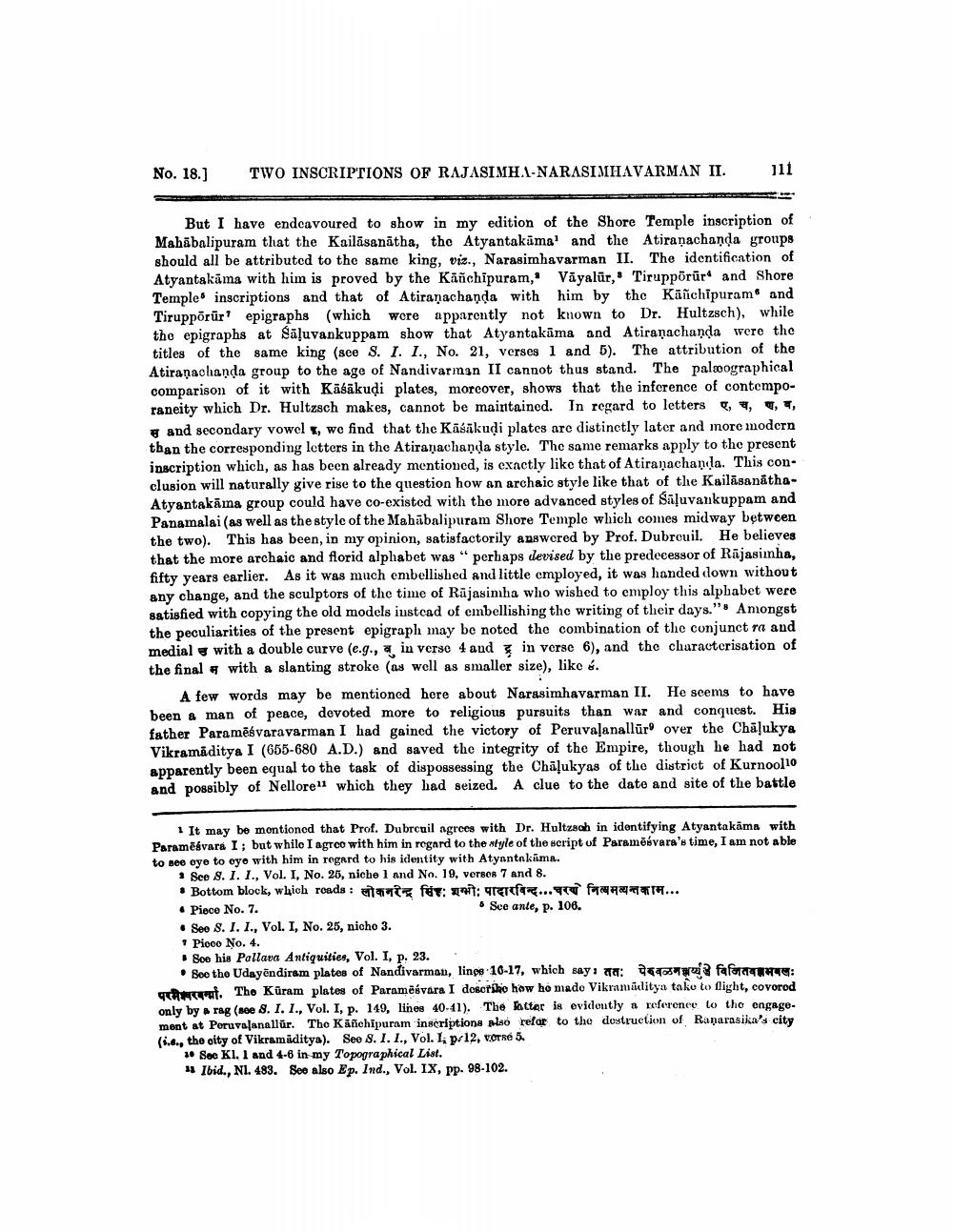________________
No. 18.]
TWO INSCRIPTIONS OF RAJASIMHA-NARASIMHAVARMAN II.
11
But I have endeavoured to show in my edition of the Shore Temple inscription of Mahābalipuram that the Kailāsanātha, tho Atyantakama! and the Atiranachanda groups should all be attributed to the same king, viz., Narasimhavarman II. The identification of Atyantakāma with him is proved by the Kanchipuram, Vāyalür, Tiruppörürt and Shore Temples inscriptions and that of Atiranachanda with him by the Kanchipuram and Tirupporūr' epigraphs (which were apparently not known to Dr. Hultzsch), while the epigraphs at Sāļuvankuppam show that Atyantakāma and Atiranachanda were the titles of the same king (see S. I. I., No. 21, verses 1 and 5). The attribution of the Atiranachanda group to the age of Nandivarman II cannot thus stand. The palmographical comparison of it with Käsākudi plates, moreover, shows that the inference of contemporaneity which Dr. Hultzsch makes, cannot be maintained. In regard to letters , , , ,
and secondary vowel , we find that the Kāsākudi plates are distinctly later and more modern than the corresponding letters in the Atiranachanda style. The same remarks apply to the present inscription which, as has been already mentioned, is exactly like that of Atiranachanda. This conclusion will naturally give rise to the question how an archaic style like that of the KailāsanāthaAtyantakāma group could have co-existed with the more advanced styles of Sāļuvankuppam and Panamalai (as well as the style of the Mahabalipuram Shore Temple which comes midway between the two). This has been, in my opinion, satisfactorily answered by Prof. Dubreuil. He believes that the more archaic and florid alphabet was "perhaps devised by the predecessor of Rājasimha, fifty years earlier. As it was much embellished and little employed, it was handed down without any change, and the sculptors of the time of Rajasinha who wished to employ this alphabet were satisfied with copying the old models instead of embellishing the writing of their days.". Amongst the peculiarities of the present epigraph may be noted the combination of the conjunct ra and medial with a double curve (e.g., in verse 4 and zin verse 6), and the characterisation of the final with a slanting stroke (as well as smaller size), like é.
A few words may be mentioned here about Narasimhavarman II. He seems to have been a man of peace, devoted more to religious pursuits than war and conquest. His father Para mēs varavarman I had gained the victory of Peruvalanallur over the Chāļukya Vikramaditya I (655-680 A.D.) and saved the integrity of the Empire, though he had not apparently been equal to the task of dispossessing the Chāļukyas of the district of Kurnool10 and possibly of Nellorell which they had seized. A clue to the date and site of the battle
1 It may be montionod that Prof. Dubrouil agrees with Dr. Hultzsch in identifying Atyantakäms with Paramekvara I ; but whilo I agree with him in regard to the style of the script of Paramośvara's time, I am not able to see oye to oyo with him in regard to his identity with Atynntakama.
* See 8. I. I., Vol. I, No. 25, niche 1 and No. 19, versos 7 and 8. • Bottom block, which roads : layifut: 29: ET ...
TH... • Piece No. 7.
See ante, p. 106. • See 8. I. I., Vol. I, No. 25, nicho 3.
Piooo No. 4. • Soe his Pallava Antiquities, Vol. I, p. 23. • Bootho Udayēndiram plates of Nandivarman, linge 16-17, which say: ma: 0
faforume: quat. The Kuram plates of Paramēsvara I descriko how ho mado Vikramaditya tako to flight, covorod only by rag (see 8. 1. 1., Vol. I, p. 149, lines 40-41). The factor is evidently a referenee to the engage. mont at Poruvasanallür. Tho Käfichipuram inscriptions also refer to the destruction of Ranarasika's city (i..., the city of Vikramaditya). See 8. I. 1., Vol. 1. p.12. VOTRE
1. See Kl. 1 and 4-6 in my Topographical List. 1 Ibid., NL. 483. See also Ep. Ind., Vol. IX, pp. 98-102.




